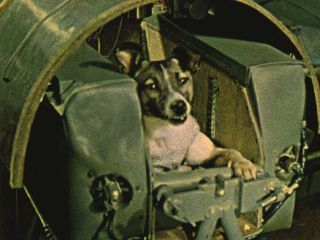A remarkable mission of the Soviet Union
The date was November 3, 1957, the Soviet Union launched Sputnik 2, which made history because it carried Laika, the first living creature to go around the Earth. The flight was supposed to test whether it is safe for people to go into space, but Laika didn’t come back.

Even though everyone agrees that Laika made it into space, no one knew for a long time how long she survived after that.
The reason for choosing Laika
Laika was a small, calm, mixed-breed dog who weighed only 13 pounds (6 kilograms). She was one of several stray dogs rescued from the streets and selected for the Soviet space program.
Only female dogs were utilized for the experiment since it was determined that their anatomy was better adapted for close confinement compared to that of male dogs.
According to reports, she prepared herself for life on board the satellite by becoming accustomed to live in more cramped spaces as part of her training. She was accustomed to variations in gravitation by being spun in a centrifuge. Also, she learned to accept food in the form of jellies so that it could be easily provided in an environment with no weight.
The reason for choosing animals for space by the Soviet Union
Animals were used in research in a variety of countries, not only in the Soviet Union. One of the theories that were considered before humans actually set foot in space was the possibility that they would not be able to withstand prolonged durations of weightlessness.
As reported by NASA, American and Russian scientists used animals, primarily monkeys, chimpanzees, and dogs, to test each country’s ability to launch a living entity into space and bring it back safely.
Moreover, Soviet rocket scientists sought to study the effects of microgravity and spaceflight on the human body by sending dogs into space.
Reports show that only obedient animals were chosen for the experiments and those who could withstand the most extreme conditions, such as intense noise and rapid changes in atmospheric pressure were selected by the rocket engineers.
Laika was not the first animal to be tested on
Even though Laika is famous, she was not the first dog to go into space. In 1951, the Soviet Union sent two dogs named Dezik and Tsygan into space. However, before Laika, dogs were only used for sub-orbital launches.
What actually happened to Laika?
The announcement of the launch pushed Laika to instant fame around the world. Reporters quickly began calling the spacecraft and its passenger “Muttnik.” Soviet sources from the time of the expedition suggested that the dog was kept alive for six or seven days before being killed with poisoned food because of a lack of oxygen. The satellite burned up upon re-entry into Earth’s atmosphere on April 14, 1958. The tragic end that happened with Laika provoked widespread outpourings of emotion.
In 2002, a Russian scientist said that the stories about how she died before were not true. Laika died from heat exhaustion and fear, and only after five to seven hours, since launch.
Long after Laika had passed away, the spacecraft continued to orbit the Earth despite having all of its systems turned off. It was only five months later, on April 14, 1958, when the spacecraft reentered the atmosphere of Earth and burned up during reentry.
A Hero Among Dogs
Laika proved that a living being could enter space. However, her death sparked global debates about animal rights. Laika and the other animals who made space flight possible were regarded as heroes in the Soviet Union.
Read More: Another Long March Module Space Debris to Hit Earth in Upcoming Days













